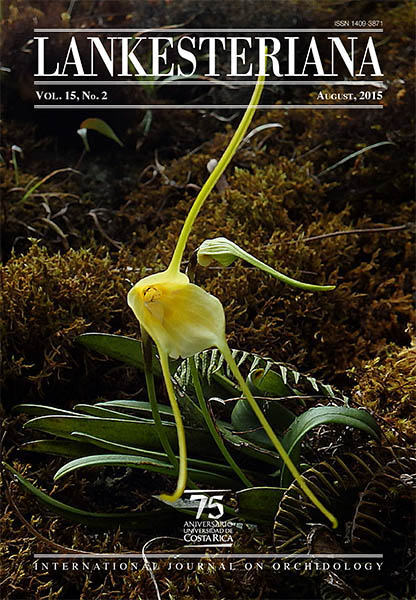Protocorm-like bodies and plant regeneration from foliar explants of Coelogyne flaccida, a horticulturally and medicinally important endangered orchid of Eastern Himalaya
DOI:
https://doi.org/10.15517/lank.v15i2.20747Keywords:
Coelogyne flaccida, foliar explant, micropropagationAbstract
An efficient induction of protocrom-like bodies (PLBs) and plantlet regeneration from the young leaves of in vitro grown seedlings of Coelogyne flaccida, an horticulturally and medicinally important endangered epiphytic orchid, was accomplished in order to develop mass-scale propagation. The young leaves (1.5 cm in length) from 110 days old aseptically germinated seedling were grown in vitro in Murashige and Skoog’s (MS) medium supplemented with different concentrations and combinations of NAA ( 0.5-2 mg/L), BAP (0.5-2 mg/L) and Kn ( 0.5-2 mg/L ). The explants produced protocorm-like bodies directly from the epidermal cells of leaf without the formation of intervening callus tissue within four weeks of culture. The highest number of plantlets regenerated through PLBs per explant after 15 weeks was 35-36 in presence of NAA (2mg/l) and Kn (2mg/l). Within 20-25 weeks individual plantlets produced 2-3 leaves and 2-3 roots. Chromosome number from all plants regenerated from leaf explants showed the same chromosome number as the mother plant as 2n = 40. During acclimatization, 80% of the plantlets survived after one month of transplantation.
Downloads
Downloads
Published
How to Cite
Issue
Section
License
According to the Open Access policy promoted by the University of Costa Rica, all the papers published by Lankesteriana are licensed under the Creative Commons copyright and can be downloaded free of charge. The journal holds copyright and publishing rights under the CC BY-NC-ND 3.0 CR license.
Before the publication of the materials submitted by the author(s) in LANKESTERIANA, the author(s) hereby assign all rights in the article to the Lankester Botanical Garden.








